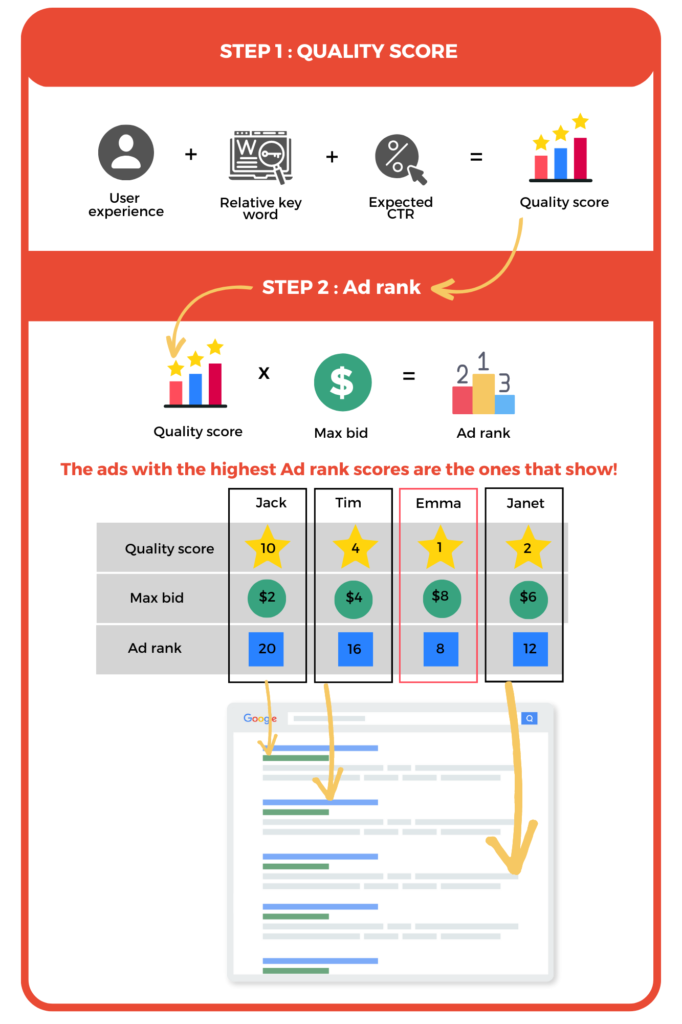
The Beginner’s Guide to PPC: Everything You Need to Know
What is PPC?
PPC stands for Pay-Per-Click advertising, which is a type of digital marketing where advertisers pay a fee each time their ad is clicked. It’s a form of online advertising that enables businesses to place ads on search engines, social media platforms, and websites, and only pay when someone clicks on their ad. This advertising model is beneficial for businesses as they can target specific audiences, reach a large number of potential customers, and monitor their advertising campaign’s performance in real time. Some of the platforms that offer PPC ads are Google, Bing, Yahoo, and Facebook. PPC advertising is a cost-effective and measurable way for businesses to drive traffic to their website and increase conversions. In this article, we will discuss in depth what PPC marketing is, how it works, and why it is important for businesses to consider this type of advertising as part of their digital marketing strategy.
Here’s how PPC advertising works in more detail:
PPC advertising looks different from platform to platform, but in general, the process is as follows:
Keyword research
Advertisers identify the keywords they want their ads to appear for, such as “buy shoes” or “best running shoes.”
Ad creation
Advertisers create ads that are relevant to the keywords they’ve selected and include a compelling call to action.
Auction
Advertisers place bids on the keywords for which they want their ads to appear. This is known as an auction, and the winning bids determine which ads will be shown to users when they search for the selected keywords.
Ad placement
The ads are then displayed on SERPs, websites, or social media platforms.
User engagement
When a user clicks on an ad, they are directed to the advertiser’s website or landing page. The advertiser is then charged a fee, hence the term “pay-per-click.”
Conversion tracking
Advertisers track conversions, such as a purchase or sign-up, to determine the effectiveness of their
ads and make adjustments to their strategy as necessary.
PPC advertising is an effective way for businesses to reach potential customers who are actively searching for products or services they offer. By targeting specific keywords and only paying for actual clicks, PPC can be a cost-effective advertising solution with a high return on investment (ROI).
What is Google Ads?
Google Ads is the single most popular PPC advertising system in the world. It allows businesses and individuals to create and display ads on Google and its advertising network. The ads appear in various forms, including text, image, video, and shopping, and can be targeted to specific audiences based on demographics, interests, keywords, and geographic location. With Google Ads, advertisers bid on keywords or phrases that are relevant to their business and pay every time someone clicks on their ad. The platform uses a sophisticated algorithm to determine which ads to display and how much to charge for each click, making it a cost-effective way for businesses to reach potential customers.
How Google Ads’ PPC system function
The basic process of running a PPC ad campaign on AdWords is as follows:
Determine your goals
The first step is determining your goal. What do you want to achieve with your PPC campaign? increased website traffic, leads, sales, and brand awareness? Having clear goals will help you determine the target audience and keywords for your ads.
Account Creation
The second step is to create a Google AdWords account, which allows you to create, run, and manage your PPC campaigns.
Keyword Research:Research the keywords that people are using to search for products or services like yours. You will use these keywords to create targeted ads.
Ad Creation
You create ads that consist of a headline, a description, and a display URL. You’ll also choose the landing page that people will go to when they click on your ad.
Bid and Budget
Determine how much you want to spend on each click of your ad, and set a daily budget for your campaign.
Targeting
Choose the locations, languages, and devices you want your ad to appear on. You can also set a specific schedule for when your ad should be shown.
Launch
Once you have set up your campaign, you can launch it and your ads will start appearing on Google’s search engine results pages and other websites on the Google Network.
Monitoring and Optimisation
You can monitor the performance of your campaign by tracking metrics such as click-through rate (CTR), cost-per-click (CPC), and conversion rate. Based on these metrics, you can adjust your bids, ad copy, targeting, and budget to optimise your campaign for better performance.
By carefully choosing your keywords, targeting, and ad copy, you can create an effective PPC campaign that drives targeted traffic to your website and helps you reach your business goals.
How Google rates your ad

Google uses a powerful auction-style formula to decide which ads appear for any particular search. When your ad enters into the auction, the PPC system will allocate a Quality Score from 1- 10 based on your ad’s relevance to the keyword, your expected click-through rate, and landing page quality.
It will then multiply your Quality Score by your maximum bid (the highest amount you’re willing to pay for a click on that ad) to determine your Ad Rank. The ads with the highest Ad Rank scores are the ones that will show up.
To get maximum profits from PPC, you need to learn how to do it right.
How to do PPC with Google Ads
Running PPC ads with Google Ads is valuable as Google is the market leader in the Search market with a share of around 84.08 percent and hence has the potential to drive a massive amount of traffic to your ad and increase the impressions and clicks to your ad. The appearance of your ad is based on which keywords and match types you choose. While several factors determine the success of your PPC ad campaign, it can be enhanced by following the steps below.
- Bid on relevant keywords
picking relevant PPC keyword lists, keyword groups organised in different ad groups based on common themes, and proper ad text. - Focus on the quality of the landing page
Create landing pages optimised with the keywords with persuasive, relevant content and a clear call to action that aligns with the user’s intention. - Improve your Quality Score
Improve your Quality Score by increasing the quality and relevance of your keywords, landing pages, and PPC campaigns. The bigger your Quality Score is, the more your ad clicks will be at lower costs. - Capture attention
Attractive ad copy is vital in search ads and for display or social ads, eye-catching creatives with persuasive copy are key.
PPC keyword analysis
Keywords are the foundation of PPC campaigns. Keyword research is extremely time-consuming, but at the same time, it is incredibly important. That is why most successful Google advertisers will constantly refine and grow their keywords list. Keyword research is something you need to do continuously otherwise you will be losing out on hundreds of long-tail, low-cost, highly relevant keywords that could drive more traffic to your site. In short, a well-chosen keyword list should be
Relevant: The keywords you bid on should be closely related to the product or service you sell, otherwise you will be wasting money on irrelevant keywords.
Exhaustive: You should add more, specific and less common long tail keywords along with the most popular and frequently searched terms in your niche. These long-tail keywords will account for the majority of search-driven traffic, apart from being less competitive, and therefore less expensive.
Expansive: You should keep on refining and improving your campaigns based on your understanding of how the keywords perform. Grow your keywords list so that you get maximum clicks that convert from the campaigns.
Control of PPC campaigns
To effectively monitor PPC campaigns, it is important to regularly check key metrics such as click-through rates (CTR), conversion rates, cost per click (CPC), and cost per conversion. It is also crucial to monitor the relevance and quality of the keywords used in the campaign and make adjustments as necessary to optimize results. Another effective way to monitor PPC campaigns is to use tracking tools such as Google Analytics, which provides data on the performance of the campaign, user behaviour on the website, and the effectiveness of ad placement. Regularly reviewing and analysing
data from these tools can help identify areas for improvement, making it easier to make informed decisions about how to optimise the campaign and achieve desired results.
You should be continuously analysing the performance of your account and making the following adjustments to optimise your campaigns:
- Don’t stop adding new PPC keywords: Attract more people to your PPC campaigns by adding more keywords that are relevant to your business.
- Add negative keywords: To increase advertising relevance and cut back on wasteful spending, add non-converting terms as negative keywords.
- Keep an eye on costly PPC keywords: Identify and review expensive, under-performing keywords and eliminate them from the list.
- Refine landing pages: Make sure you fine-tune your landing pages so that the content and CTAs of the landing pages align with the search queries and hence convert well.
- Split ad groups: By dividing your ad groups into smaller, more relevant ad groups, which enable you to generate more targeted ad copy and landing pages, you may increase click-through rate (CTR) and Quality Score.

